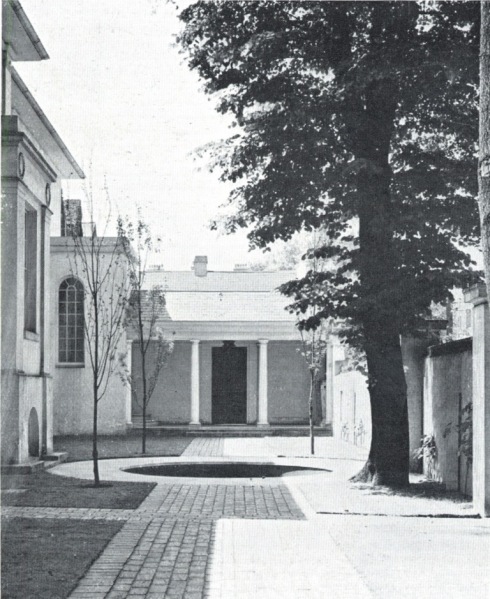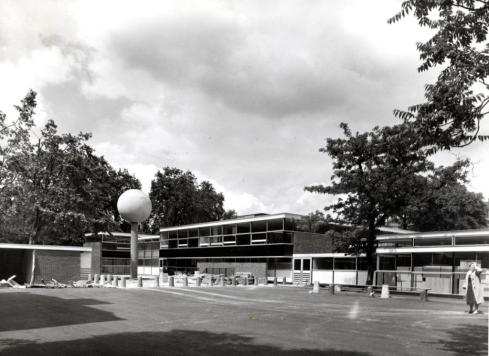When I was writing some of the recent posts about the Old Brompton area I made a list of the named individual houses along and near the Old Brompton Road to help me. The fascination of that area for me is that almost all of it was completely redeveloped in the second half of the 19th century and in the whole of the 20th, so that the quiet semi-rural road with seperate houses, inns and market gardens is now gone and was hardly touched by the age of photography. It now has to be known using maps and water colour paintings. Both can be tools of the imagination as much as records of how things looked. So Old Brompton is partly a fantasy world, partly a place reconstructed from books and plans.
However some of those houses were photographed. This week’s post is about one of those and the remarkable building that replaced it.
If you go eastwards from the modern Coleherne Court you pass a stretch of road which was called Bolton Gardens. In one of the group of eight houses there was the house where Beatrix Potter lived as a child. Behind it was South Bolton Gardens where there were three large houses: Rathmore Lodge, Osborn House and Bladen (or Bladon) Lodge. The modern version of this street is a cul-de-sac leading to Bousfield School which was built in 1954-56. . This is a view of the south front of Bladen Lodge.
The original Bladen Lodge was built in 1836, an unremarkable house with a substantial garden (though much smaller than that of Hereford House / Coleherne Court). In 1927 a Mr C L Dalziell acquired it and in 1928 had two wings added to the east and the west. The architect was Clough Williams-Ellis. His name will be familiar to fans of the 60s TV series the Prisoner as the creator of the location of the series, the exotic Italianate village of Portmerion in Wales.
This shows the Mediterranean paved garden on the north side of the house with its enigmatic pond. It’s quite different from the nearby houses but oddly recaptures the seclusion of the walled gardens of older and more modest houses like the long gone Hawk Cottage.
William Cowen might have been impressed by William-Ellis’s improvements which almost doubled the size of Bladen Lodge.
I could easily imagine this view as part of the Village. It has the same other-wordly quality as Portmerion, particularly when I recall my first pre-video viewings of the Prisoner in cool black and white. Here is a view of part of Portmerion:
Inside Bladen Lodge was really another English country house.
The interior is less packed with decoration than the old Coleherne Court and there were a few modernist touches here and there but the old pattern of drawing room, dining room:
And above all the library was retained:
Bladen Lodge was bombed during the war and the site largely cleared. There were proposals for a block of flats but the London County Council already had an eye on the site for a new school. They acquired several houses in Bolton Gardens to expand the site and built Bousfield School in 1954-56.
Here I declare an interest. Bousfield School is a striking building and I’ve been aware of it since I first worked in the area. But my son (now the transport consultant to the blog, as well as a technical advisor on IT matters) went to the school in the 90s so I’ve been in and out of the buliding many times and have grown very fond of it.
The post-war schools building programme was a decisive break with the old county schools of London. It owes more to Le Corbusier than the tall sometimes gloomy Edwardian schools that still survive in many parts of London.
A “villa in a park” was what the architects Chamberlin, Powell and Bon were aiming for, and that is pretty much what they got.
At the rear is that curious sphere on a pole, a water tower, which still causes passers-by to do a double take. It also just struck me that it bears a certain resemblance to Rover the strange bubble device which pursued Number 6 and the others in the Prisoner. That woman on the right looks perturbed about something.
The entrance has an ornamental pond, still frequented by water fowl despite its small size.
The interior is light, airy and full of space, even when dozens of children are moving around it at a rapid pace.
This staircase reminds me of the interior of the Mendelsohn house in Old Church Street.
So although it’s a shame that Williams-Ellis’s 20th century reworking of a Georgian house no longer exists, Bousfield School adds some post war distinction to predominantly 19th century stretch of road.
I’m adding a couple of bonus pictures to complete this look at the junction of Old Brompton Road and the Boltons. On the east side of the Boltons another house was built two years after Bladen Lodge.
This was Sidmouth Lodge. The Survey of London with its usual eye for the telling detail describes the facade as “neo-Greek…with a grave and narrow entrance between Ionic columns”. Once this is pointed out the slightly faded photograph does catch a slightly mortuary look to the entrance. Behind this view was a house built in 1842 by Robert Gunter as a cottage for yearly letting which was given the intriguing name of Moreton Tower. I haven’t been able to find a picture of that unfortunately.
Sidmouth House was demolished in 1939. A telephone exchange was built on the site. That building still exists sitting incongruously on the edge of the oval of large villas which forms the Boltons. More of them another time perhaps.
Finally, go back to that list of Bladen Lodge’s neighbours. One of those houses, Osborn House built in 1805 is still with us, possibly the last survivor of Old Brompton now nestled right against the grounds of Bousfield School.
I took this photograph a few weeks ago while I was doing some field work for another quirky building tale of old Brompton which I may yet lay before you.
Postscript
As you may have guessed I was a little pushed this week. Not only was I off work for a few crucial days but my computer at home, a long serving Dell Studio died tragically preventing me working on this post there. But I was very taken with the pictures of Bladen Lodge which come from Country Life of March 1934 and wanted to use them even if there weren’t quite enough. I’m working on yet another old Brompton post but I won’t do that for a little while, to give you a bit of a rest.
The image of Portmerion is from this excellent site devoted to black and white photography:
http://lookingattheworldinblackandwhite.blogspot.co.uk/2012/06/portmeirion.html
Incidentally, my son like many others of his generation finds my devotion to the Prisoner inexplicable. He’d rather watch Hong Kong buses and Russian car crashes.
Postscript to the postscript
I don’t normally come back to posts to add stuff but I thought this detail from the 1862 OS map might help a bit.


















